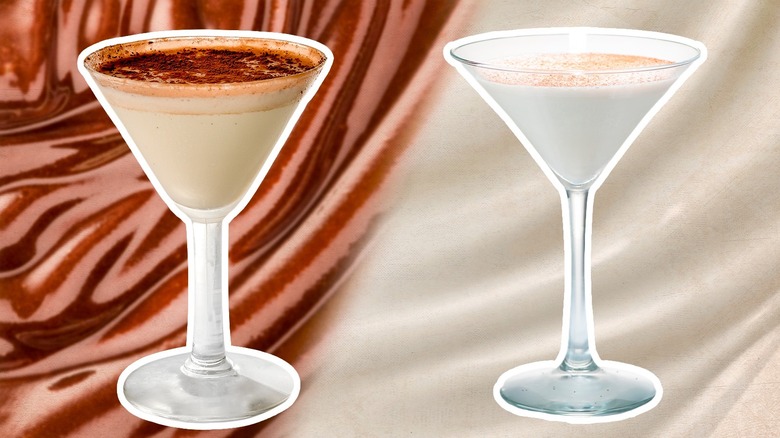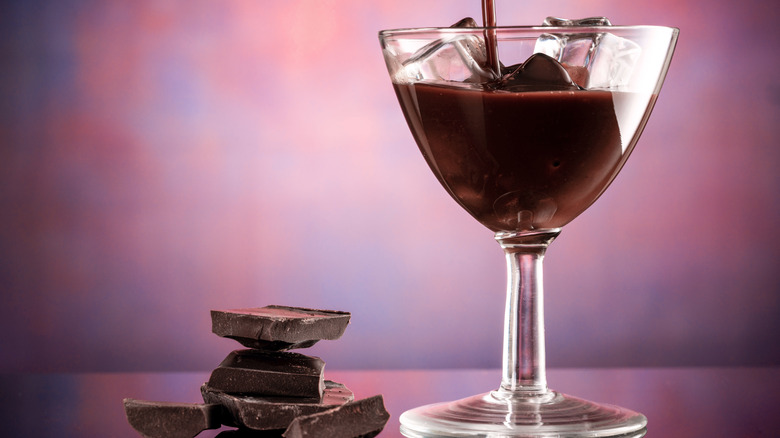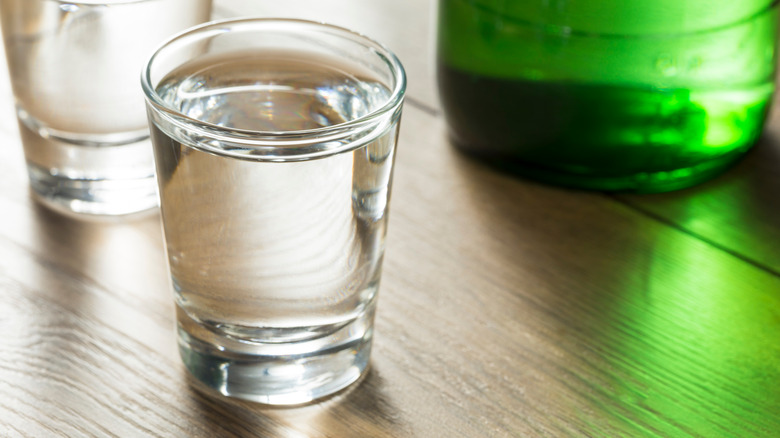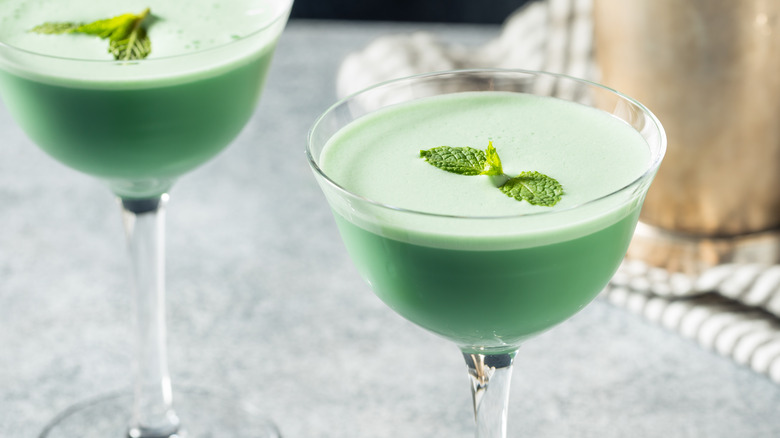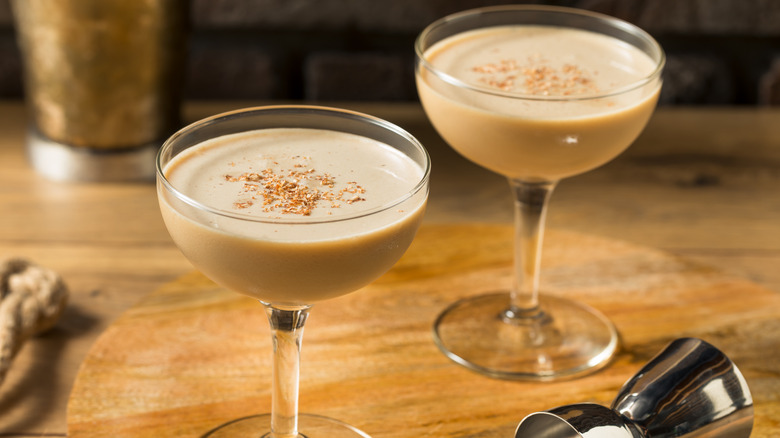Dark Creme De Cacao Vs White: What's The Difference?
In the world of mixology, there are many ways of introducing flavors. From the base spirit to syrups, juices, extracts, garnishes, and more, imbuing taste comes in many forms. A particularly effective — and purposefully crafted — cocktail ingredient is a liqueur.
These infused spirits, made by adding a tasty ingredient or two to a liquor, come in a wide range of flavors, styles, and strengths. Some, like Campari and Cointreau, have become beloved classics. However, navigating lesser-known liqueurs can be tricky, with unregulated differences from one manufacturer to the next. This is especially true for creme de cacao, a liqueur that is usually formed from a grain spirit and crafted with chocolate, sweeteners, and often, vanilla.
With a white and dark version, visually delineating the two types is straightforward. However, when it comes to flavor and texture, it all comes down to the manufacturer. Some dark creme de cacaos taste the same as the white, only distinguished by a dye. Meanwhile, others take on a completely distinct method of suffusing the drink with chocolate flavor. Knowing the ins and outs pays off, as the making methods affect the resultant drinks, so let's dive into principal differentiating characteristics.
What is dark creme de cacao?
As per its name, dark creme de cacao takes on varying dark shades of brown, mirroring chocolate's hues. Although creme is in its name, no dairy products are utilized in the production; it's not similar to Irish cream. Instead, dark creme de cacao is made by mixing a neutral spirit with flavor extracted from cacao seeds as well as plenty of sugar. It has a bolder more dark-chocolatey taste than the white version.
There are two methods of infusing liquor with the cacao flavor. The first, more classic method of creating the dark version relies on percolation. The chosen base liquor percolates through a container full of cocoa beans, yielding a bold, chocolate-forward result. Early versions of the liqueur were crafted by soaking whole cocoa beans in alcohol.
However, nowadays, most expressions rely on cacao distillate, which is more clear and light in nature. From there, the brown color is achieved through the use of caramel or food dye. Unfortunately, this can introduce an off-putting flavor. This is why some producers, like Tempus Fugit, go for a more natural brown color by macerating the distillate with more cocoa beans.
What is white creme de cacao?
Some anticipate a dense, thick liquid when picturing white creme de cacao liqueur, but in fact, most are completely clear. A few may take on a different hue, like Marie Brizard cacao blanc, which has a pale yellow tint, or a homemade version made by infusing clear alcohol with cocoa butter, which will probably turn cloudy.
While small-scale versions are crafted with this fatty infusion from the chocolate-making process, store-bought mass-made versions nearly entirely rely on a cacao distillate. Some directly bottle the resultant cocoa bean distillation, while others infuse a spirit — like brandy — to achieve a more complex taste.
Many creme de cacao brands offer flavors in addition to chocolate, with coffee-like bitterness, fruity notes, and spice, through the integration of vanilla and sometimes botanicals. White creme de cacao tends to have a milder chocolate taste than the dark version, often with vanilla undertones. The texture is typically on the thicker side, due to the generous addition of sugar. Renditions differ from one to the next, lending a unique character based on the purchased bottle. It's really a question of reading labels for ingredients and taste-testing to find your preference.
White creme de cacao brings soft chocolate flavor to cocktails
While both liqueurs can be delicious, white creme de cacao's delicate nature lends it more varied uses in mixing. Not only does its clear color combine well with other ingredients, but its soft tinge of chocolate tends to be less dominant. As a result, creme de cacao appears in many classic, elegant drinks.
There's the 20th century, a luxury train-inspired cocktail from the 1930s. Crafted with gin, Lillet blanc, lemon juice, and white creme de cacao, the drink is a mix of herbal and sour flavors, tempered with a soft chocolate taste. The mix is deliciously riffable, easily replaced with other base spirits like reposado tequila or bourbon.
White creme de cacao also beautifully pairs with pisco, playing with the unaged brandy's floral and aromatic character. Throw in cognac, wine, sherry, and even cacao spirit into the mix for more creative and complex cocktails.
And while the liqueur works fabulously in such sleek slings, it is good in dessert-type drinks, too. There's the beloved grasshopper cocktail, which employs equal parts creme de menthe, creme de cacao, and heavy cream to craft a sumptuously creamy result, that's perfect for sipping post-dinner. And if you're keen for something that was invented to be drunk at breakfast, mix up a decadent Ramos gin fizz with an added dose of creme de cacao. The chocolate liqueur will meld pleasingly into the lengthy list of ingredients in this concoction, too.
Dark creme de cacao cocktails have bold chocolate character
As opposed to its white variety, dark creme de cacao brings a bold and chocolate-forward character to cocktails. With its robust color and rich flavor, it's an ingredient that'll be hard to miss in a drink. Therefore, it's frequently paired with other hefty liquids like cream, or strong spirits and liqueurs.
One of its most famous applications is in the brandy Alexander, a prohibition-era cocktail used to mask the flavor of gin. Nowadays, the drink combines the creme de cacao with brandy and cream, to offer a thick, sweet, and delicious sip. For another dessert-like creation, creme de cacao adds a quintessential chocolate note to the thick and creamy bushwacker, made with rum, milk, and cream of coconut.
In addition to creamy creations, the liqueur imbues its chocolate notes to boozy drinks. It's a fun addition to a martini, which can be further expanded with added flavors like sherry, mezcal, and other aromatic ingredients. Similarly, the dark liqueur also works in the sidecar and can even add a tasty touch of chocolate to a daiquiri.
And sometimes, there's a magic to using both the white and dark versions in unison. Some renditions of the grasshopper reach for both styles, to make a drink that runs the full gamut of cocoa flavors.
